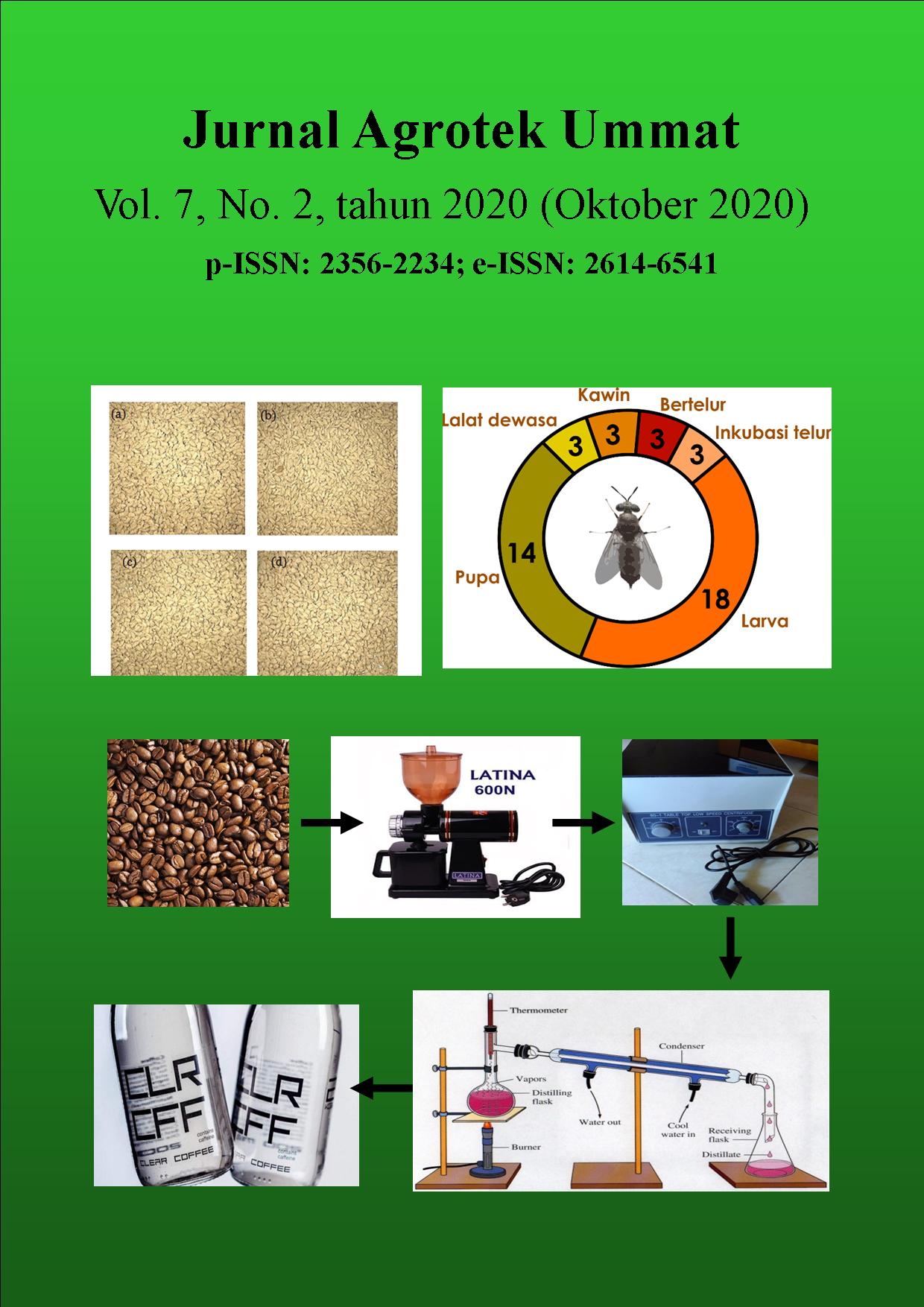RANCANG BANGUN DAN UJI KINERJA PENERAPAN TEKNIK IRIGASI TETES PADA LAHAN KERING
DOI:
https://doi.org/10.31764/jau.v7i2.3128Keywords:
Irrigation Drops, Watering Discharge, The Coefficient of Uniformity, Dry LandAbstract
The purpose of this study was to design and test the performance of drip irrigation techniques on dry land. This research method used a completely randomized design with 3 treatments, namely the faucet slope of 150 , 450, and 900 with 4 replications. In order to obtain 12 experimental sample units. Furthermore, the design results were carried out by testing the droplet discharge, uniformity coefficient, wetted soil area, and the amount of water needed during the vegetative growth of tomato plants. The test results based on the discharge value and the uniformity of drops show that the drip irrigation technique design is very good for application on dry land. Based on the discharge value, the wetted area is obtained with a wetting width of 25 cm and a depth of up to 35 cm. So that during the vegetative growth of tomato plants in treatment 150 Â requires 10200 ml / day of water, 12200 ml / day in treatment 450 , and 30800 ml / day in treatment 900 . Seeing the effect on tomato plant growth, it can be concluded that 150Â is the best treatment to apply. on dry land.References
Amuddin, A., & Sumarsono, J. (2015). Rancang Bangun Alat Penyiraman Tanaman Dengan Pompa Otomatis Sistem Irigasi Tetes Pada Lahan Kering (Design Tools Watering Plants With Automatic Pump to Drips Irrigation System For Dry Land). Jurnal Ilmiah Rekayasa Pertanian Dan Biosistem. https://doi.org/10.29303/jrpb.v3i1.8
Djumali, & S., M. (2014). Pengaruh Kelembaban Tanah Terhadap Karakter Agronomi, Hasil Rajangan Kering Dan Kadar Nikotin Tembakau. Berita Biologi 13(1) - April 2014.
Ekaputra, E. G., Yanti, D., Saputra, D., & Irsyad, F. (2017). Rancang Bangun Sistem Irigasi Tetes untuk Budidaya Cabai (Capsicum Annum L.) dalam Greenhouse di Nagari Biaro, Kecamatan Ampek Angkek, Kabupaten Agam, Sumatera Barat. Jurnal Irigasi. https://doi.org/10.31028/ji.v11.i2.103-112
Fajar, A., Abdullah, S. H., & Priyati, A. (2018). Rancang bangun dan uji kinerja sistem kontrol fertigasi dengan irigasi tetes. 5(1), 19–29.
Franata, R., Oktafri, & Tusi, A. (2014). Rancang Bangun Sistem Irigasi Tetes Otomatis Berbasis Perubahan Kadar Air Tanah Dengan Menggunakan Mikrokontroler Arduino Nano. Jurnal Teknik Pertanian Lampung.
Haridjaja, O., Putro, D., Baskoro, T., & Setianingsih, M. (2013). Perbedaan Nilai Kadar Air Kapasitas Lapang Berdasarkan Metode Alhricks , Drainase Bebas , Dan Pressure Plate Pada Berbagai Tekstur Tanah Dan Hubungannya Dengan Pertumbuhan Bunga Matahari ( Helianthus annuus L .) Different Levels of Field Capacity by Alhri. 15(2), 52–59.
Indarta, A. H., & Tuasikal, H. (2020). Rancang Bangun Dan Evaluasi Kinerja Irigasi Mikro Di Pulau Haruku , Maluku Design And Performance Evaluation Of Micro-Irrigation In Haruku Island , Maluku. 15(1), 31–44.
Mulyani, A., & Las, I. (2008). Potensi Sumber daya Lahan dan Optimalisasi Pengembangan Komoditas Penghasil Bioenergi di Indonesia. Jurnal Litbang Pertanian.
Phocaides, A. (2007). CHAPTER 7: Water quality for irrigation. Handbook of Pressurized Irrigation Techniques.
Purwanto, & Ikhsan, J. (2013). Analisis Kebutuhan Air Irigasi pada Daerah Irigasi Bendung Mrican1. Jurnal Ilmiah Semesta Teknika.
Ridwan, D. (2013). Model Of Drip Irrigation Network With Local Material Based For Agricultural Small Land Oleh : 8(2), 90–98.
Rizal, M. (2013). Rancang Bangun Dan Uji Kinerja Sistem Kontrol Irigasi Tetes Pada Tanaman Strawberry (Fragaria Vesca L). Jurnal AgriTechno.
Sarwani, M. (2013). Karakteristik dan Potensi Lahan Sub Optimal untuk Pengembangan Pertanian di Indonesia.
Selvamurugan, M., Chamy, I., Pandian, V. N., & Manikandan, M. (2018). Effect of drip fertigation and plastic mulching on growth and yield of tomato. Journal of Applied Horticulture. https://doi.org/10.37855/jah.2018.v20i01.14
Downloads
Published
Issue
Section
License
Authors who publish articles in Jurnal Agrotek Ummatagree to the following terms:- Authors retain copyright of the article and grant the journal right of first publication with the work simultaneously licensed under a CC-BY-SA or The Creative Commons Attribution–ShareAlike License.
- Authors are able to enter into separate, additional contractual arrangements for the non-exclusive distribution of the journal's published version of the work (e.g., post it to an institutional repository or publish it in a book), with an acknowledgment of its initial publication in this journal.
- Authors are permitted and encouraged to post their work online (e.g., in institutional repositories or on their website) prior to and during the submission process, as it can lead to productive exchanges, as well as earlier and greater citation of published work (See The Effect of Open Access).

